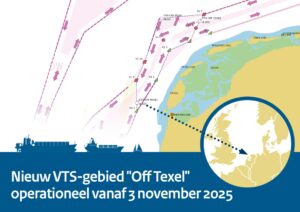Container vessel “MSC Zoë” lost 342 containers at sea, whilst passing the Frisian Island in 2019. The cause of this incident was to be attributed to severe weather conditions.
Among others, the Dutch Safety Board investigated into the incident with m/v “MSC Zoë”. The Dutch Safety Board arrived at the conclusion that active traffic guidance would be necessary to reduce risks for passing vessels in severe weather conditions, particularly when waves are perpendicular to the shipping route. Various politicians also expressed a desire to introduce active traffic guidance on these busy shipping routes.
Active traffic guidance
A new vessel traffic service (VTS) has been introduced on 3 November 2025. The new VTS area enables traffic controllers to actively advise ships 24/7 to take the northern route instead of the southern route in adverse weather conditions, as the latter is closer to the vulnerable Wadden Sea area. The southern route is 20 to 30 km off the coast, but has been found to pose an additional risk of cargo loss in certain wave conditions.
In June 2022, the Dutch Minister of Infrastructure and Water Management decided to introduce the new “Off Texel VTS area”. It is a joint effort of the Harbour Master of Den Helder, the Royal Dutch Navy and the Dutch Ministry of Infrastructure and Water Management to establish this new VTS area.
 Every ship must report in
Every ship must report in
A new VTS is not very often introduced. However, the legislation has now been amended, personnel has been trained and equipment has been installed to enable adequate communication with passing vessels. From 3 November 2025, any vessel wishing to enter the “Off Texel VTS area” must report via VHF channel 63.
What is a VTS area?
A VTS area is a geographically defined area on the water where vessels receive traffic guidance from a central control center, similar to air traffic control. Its purpose is to increase the safety and efficiency of shipping by providing information and coordinating traffic flows in busy areas such as ports, canals and access routes. For example, there is also a VTS area near the port of Rotterdam.
Source and photo: Dutch Ministery of Infrastructure and Water Management

